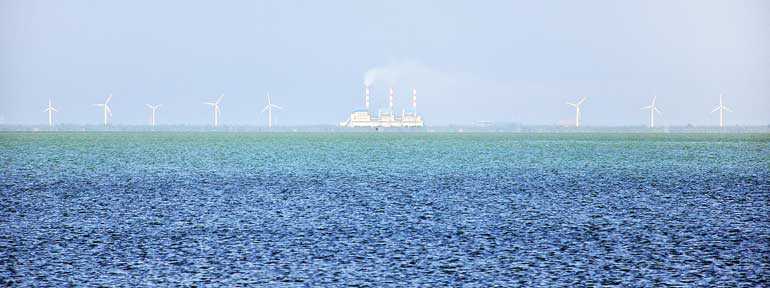Saturday Apr 05, 2025
Saturday Apr 05, 2025
Monday, 10 February 2020 00:00 - - {{hitsCtrl.values.hits}}

Large capacity operationally inflexible fossil fuelled power plants developed today for a 30+ year life time will be obsolescent within a decade. Their use will be impacted by economic factors, environmental concerns, end user preferences (seeking ‘green’ credentials) and international obligations
The Sri Lankan Cabinet recently approved the construction of two coal plants and two-LNG plants. The planned capacities of these new plants would exceed 1,000 MW. This decision is a 180-degree turn from the earlier pronouncements made by the President and the Prime Minister.
An 18 January Facebook post by President Gotabaya Rajapaksa proclaimed: “By 2030 Sri Lanka will be fulfilling 80% of its power demand through renewable energy.”
A 7 January tweet posted by Prime Minister Mahinda Rajapaksa stated: “A stark reminder that #climatechange is very real. The Australian bushfires that’s leaving a trail of mass destruction in its wake is a clear indication of it. It’s time that govts of the world unite & invest in renewable energy & sustainable env friendly methods of development.”
What has caused this sudden turnaround? Integration of almost 1,000 MW of fossil fuelled plant that must continually operate at full capacity to satisfy project economics will shut out large-scale integration of renewable energy (RE) based power. 
A paper on Cabinet decisions dated 23 January (para 7) reports on the current situation of the electricity sector in Sri Lanka and the precautions to be taken to face the shortage of electricity. It says: “Due to delay in implementing the electricity power plant projects planned, Ceylon Electricity Board has to encounter a bitter crisis.”
Averting an electricity supply crisis is a dominant factor that influences the Government decision making process. The last thing the “no nonsense, get things done” President wants is a power shortage occurring under his tenure!
It is pretty obvious that the CEB reported on the impending crisis and spelt out options to address the matter. The institution is no fan of RE and draws comfort by following a conventional generation expansion path that features use of fossil fuels.
The technocracy is familiar with the integration of block capacities of thermal power plant with hydro power assets utilised for regulation. This is how the institution expects to deliver “reliable and affordable” electricity to the Sri Lankan consumer.
Why is RE out of favour?
Those who view the power sector with a conventional mindset oppose large-scale RE integration on the basis of the following arguments:
1 Wind and solar power output is subject to resource intermittency that affects grid stability;
2 Lower plant factors of wind and solar power requires a larger quantum of capacity to be installed to match the energy yield of an equivalent capacity thermal power plant, and;
3 The costs incurred in building a greater amount of RE plant capacity with back up generation to combat intermittency results in higher electricity prices.
When CEB technocrats dismiss 4 RE on the grounds of intermittency and cost, it demonstrates their inability and/or unwillingness to understand the techno-commercial path that would be followed to harness RE resources on a large scale.
RE integration is not a simple process of generating an equivalent amount of ‘on demand’ energy that would have been available from a fossil fuelled power plant. But rather, it is a process that considers global trends, indigenous resources, applicable technologies, national development priorities and commercial arrangements to integrate RE based power that blends with existing fossil fuelled and hydro power plants. The evolving system with a diverse array of plant types and technical and commercial arrangements is choreographed to operate in manner to ensure stable and secure supply of electricity.
National development objectives
Unlike in the past where electricity was viewed as an essential element for driving industry and commerce and uplifting the quality of life of citizens, today’s power sector expansion strategy should be aligned with national development objectives that are influenced by the following:
Rapid evolution of RE technologies
Concerns about climate change, desire to minimise the global carbon foot print, quest for technological development and energy security has led to the rapid emergence of RE based power. Wind, solar, battery storage, distributed generation and control algorithms with use of advanced weather forecasting, artificial intelligence and smart technologies are making a major impact worldwide. The technology has advanced rapidly and costs have declined. Availability of standardised equipment designs that are batch/mass produced with software for control allows wind, solar and battery storage systems to be installed and integrated to existing systems on a fast track basis.
Benefits accrued by following a RE based option are; regionally based project developments, avenues for private sector investment and the emergence of highly skilled managers, engineers and technicians for developing, constructing and operating the RE based power plants and systems.
The opinion of Bloomberg New Energy Finance is worth noting: “The future electrical system will no longer be centralised, oligopolistic, polluting and analogue. It will be a decentralised, decarbonised, socialised and digitised electrical system.”
New Energy Outlook 2019 by BNEF
Pricing strategy for sale of electricity
The centralised, top-down power system expansion planning and implementation is outdated. The commonly used phrase “affordable electricity” is no longer pertinent and should not be used to drive Govt. policy. This outdated criteria is used by the monopolistic CEB to plan the bulk supply of electricity to meet the future demand on the basis of projected socioeconomic, technological and demographic developments in the country.
The smart approach for planning the future national electricity supply would be to consider consumer demographics, global/regional trends, indigenous resources available, applicable technologies, environmental concerns and use of advanced methodologies to ensure efficient and stable electricity supply. The various elements that influence the evolution of the power system will emerge with the production and distribution of electricity evolving towards a decentralised and distributed form.
This approach would lead to identification of the following categories:
Affordability should not be a criteria when supplying electricity to high end users such as tourist hotels, residents in luxury dwellings, etc. While at present, the tariff for electricity supply is varied according to units consumed, peak power demand and time of day, the commercial terms of supply should be further adjusted to reflect market conditions and to push the drive towards self-generation through use of technology.
RE technology should be utilised for supplying electricity to rural communities. With over 70% of the population rural dwellers and many receiving electricity at a subsidised rate, does it make sense for fossil fuelled power plants to supply electricity to these communities?
Is the CEB considering the risk to the economy (fuel price and currency fluctuation), losses incurred during electricity transmission and the environmental impact? Micro grids with use of solar PV and battery storage makes sense. These micro grids would have the option of a main grid connection to optimise operational economics.
Emergence of the Prosumer – A national technology driver
“High end” consumers will face a variable tariff (hourly) and peak demand charge with a smart meter processing the monthly electricity billing. This will coax consumers to produce a major portion of their electricity on-site with use of roof top solar and battery storage. The system will be grid tied and the consumer will be subject to a demand side management program. Use of smart devices will help to control and monitor the supply and consumption of electricity and reduce the utility billing.
This type of electricity consumer is known as a Prosumer (producer/consumer) and they will be subject to market pricing of electricity. The goal is to seek an optimal solution for electricity demand/supply arrangement that utilises available technologies in smart and distributed fashion.
Maximised RE penetration can be facilitated by unbundling the electricity supply industry and transitioning to a distributed generation scenario. As the path towards RE dominance is followed, various elements that influence the evolution of the power system will emerge with the production and distribution of electricity continuing towards a decentralised/distributed form.
The grid network operator will be reliant on software tools for management of distributed power systems (Internet of Things – IOTs) and will utilise control algorithms to maintain stable electricity supply.
Fossil fuelled power plants – Stranded assets in the future?
Large capacity operationally inflexible fossil fuelled power plants developed today for a 30+ year life time will be obsolescent within a decade. Their use will be impacted by economic factors, environmental concerns, end user preferences (seeking ‘green’ credentials) and international obligations.
Growing global concerns about the environment should not be taken lightly. An example that highlights the widespread concern is the pressure exerted on the aviation industry to drastically step up efforts to reduce its impact on climate change. Aircraft engine makers are hurriedly looking into new technologies and use of alternate fuels to reduce emissions and carbon footprint.
Power sector expansion – Legacy of the leadership
The national leadership faces a tough situation. The conventional path as recommended by the CEB technocrats – while proven and mastered – is obsolescent. The alternative RE path is associated with imaginary demons to instill a sense of fear and there are no forceful advocates within the state bureaucracy or academia to argue the case for RE.
Reports of studies and workshops staged on RE are confined to the Internet and libraries and used as reference material only. The silent and supine role of the national technical universities should be of concern since these institutions are responsible for preparing future technocrats to face challenges in a rapidly changing world.
Since the electricity expansion strategy contradicts the vision spelt out by the President and Prime Minister, it will be useful if the CEB experts responsible state their views at a public forum so that citizens concerned about national development matters may understand their thinking. These experts will be on record and the critical decisions taken will be open to judgement in the future.
(The writer is a Renewable Energy Specialist, former Head of Projects – GE Wind Energy North America and pioneered wind project developments in Pakistan.)
Discover Kapruka, the leading online shopping platform in Sri Lanka, where you can conveniently send Gifts and Flowers to your loved ones for any event including Valentine ’s Day. Explore a wide range of popular Shopping Categories on Kapruka, including Toys, Groceries, Electronics, Birthday Cakes, Fruits, Chocolates, Flower Bouquets, Clothing, Watches, Lingerie, Gift Sets and Jewellery. Also if you’re interested in selling with Kapruka, Partner Central by Kapruka is the best solution to start with. Moreover, through Kapruka Global Shop, you can also enjoy the convenience of purchasing products from renowned platforms like Amazon and eBay and have them delivered to Sri Lanka.
Discover Kapruka, the leading online shopping platform in Sri Lanka, where you can conveniently send Gifts and Flowers to your loved ones for any event including Valentine ’s Day. Explore a wide range of popular Shopping Categories on Kapruka, including Toys, Groceries, Electronics, Birthday Cakes, Fruits, Chocolates, Flower Bouquets, Clothing, Watches, Lingerie, Gift Sets and Jewellery. Also if you’re interested in selling with Kapruka, Partner Central by Kapruka is the best solution to start with. Moreover, through Kapruka Global Shop, you can also enjoy the convenience of purchasing products from renowned platforms like Amazon and eBay and have them delivered to Sri Lanka.